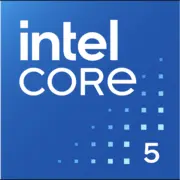Intel Core 5 220H

Intel Core 5 220H: Hybrid Power for Mobile Tasks. A Complete Review of the Raptor Lake-H Processor
Architecture and Process Technology: Hybrid Approach and 10nm Technology
The Intel Core 5 220H processor belongs to the Raptor Lake-H generation, which combines performance cores (P-cores) and efficiency cores (E-cores). This hybrid architecture is optimized for a balance between power and autonomy.
- Cores and Threads: 12 cores (4 P-cores + 8 E-cores) and 16 threads. P-cores support Hyper-Threading (2 threads per core), while E-cores operate in single-thread mode.
- Clock Frequencies: The base frequency of the P-cores is 2.7 GHz, with a maximum turbo frequency of 4.9 GHz. E-cores operate at frequencies up to 3.6 GHz.
- L3 Cache: 18 MB, which accelerates data processing in multi-threaded tasks such as rendering or video encoding.
- iGPU: The integrated Iris Xe graphics with 80 execution units supports DirectX 12, 4K displays, and Intel Deep Link technology for collaboration with discrete GPUs.
The 10nm process (Intel 7) offers improved energy efficiency compared to previous generations (e.g., Alder Lake).
Power Consumption and TDP: Balancing Power and Heating
The processor's TDP is 45W, typical for mobile H-series CPUs. However, actual power consumption can vary:
- In idle mode or light tasks (web surfing), the processor reduces its frequency to 1-2 GHz, consuming 5-10W.
- Under load (e.g., rendering), power can reach 60-70W, but only with an efficient cooling system.
Energy-Saving Technologies:
- Intel Speed Shift – Dynamic switching between P-states for instant frequency changes.
- Hardware-Guided Power Management – Optimizing workload distribution between P- and E-cores.
Performance: From Office to Gaming
Office Tasks and Multitasking
- Geekbench 6: 2542 (single-core), 10709 (multi-core). For comparison, Ryzen 5 7640HS scores about ~2400/10500, Apple M2 ~2600/9900.
- In Microsoft Office, a browser with 20+ tabs, and background file downloads, the processor operates without lag.
Multimedia and Creativity
- Premiere Pro: Rendering 1080p video takes about 8 minutes (compared to ~10 minutes for the Core i5-12500H).
- Blender (Classic BMW Test): 4 minutes 20 seconds (E-cores speed up background calculations).
Gaming
- Intel Iris Xe 80EU: In Dota 2 (1080p, medium settings) – 45-55 FPS, CS:GO – 60-70 FPS. For AAA games (like Cyberpunk 2077), a discrete graphics card is recommended.
- Turbo Mode: In games, P-cores boost up to 4.9 GHz but after 10-15 minutes, the frequency drops to 4.2-4.5 GHz due to heating (depends on the laptop's cooling system).
Use Cases: Who is the Core 5 220H Suitable For?
- Students and Office Workers: Multitasking, handling large Excel spreadsheets, video conferencing.
- Designers and Engineers: AutoCAD, Photoshop, light 3D modeling.
- Casual Gamers: Games with moderate requirements or streaming via GeForce Now.
Battery Life: How Long Will the Battery Last?
With a TDP of 45W, laptops with this processor typically come equipped with 60-80 Wh batteries. Results:
- Video Playback (YouTube, 50% brightness): 6-7 hours.
- Office Work: 5-6 hours.
- Gaming or Rendering: 1.5-2 hours.
Tip: To extend battery life, enable the "Battery Saver" mode in Windows settings and limit the processor frequency via Intel XTU.
Comparison with Competitors
1. AMD Ryzen 5 7640HS (Zen 4):
- Pros: Better multi-threaded performance (8 Zen 4 cores), lower price.
- Cons: Integrated Radeon 760M graphics is weaker than Iris Xe.
2. Apple M2:
- Pros: Up to 15 hours of battery life, cool operation.
- Cons: Limited compatibility with Windows software, weaker gaming graphics.
3. Intel Core i5-13500H (Previous Generation):
- Core 5 220H is 10-15% faster in multi-threaded tasks due to additional E-cores.
Pros and Cons
Strengths:
- High single-thread performance for mobile tasks.
- Powerful integrated graphics.
- Supports Thunderbolt 4 and Wi-Fi 6E.
Weaknesses:
- Heating under prolonged load.
- Average battery life compared to AMD Ryzen 7 U-series.
Laptop Selection Recommendations
1. Device Type:
- Ultrabooks: Not suitable due to 45W TDP.
- Gaming Laptops (ASUS TUF, Acer Nitro): Optimal choice if equipped with a discrete graphics card (RTX 4050 or similar).
- Workstations (Lenovo ThinkPad P16s): Good cooling and ergonomics.
2. What to Pay Attention To:
- Cooling System: At least 2 fans and heat pipes.
- Battery: At least 70 Wh for a balance between battery life and weight.
- Ports: Thunderbolt 4 for connecting external monitors or eGPUs.
Final Conclusion
The Intel Core 5 220H is a processor for those who need a versatile laptop for work, creativity, and moderate gaming. Its key advantages include:
- Hybrid Architecture for effective task distribution.
- Iris Xe 80EU – the best integrated graphics in its class.
- Support for Modern Standards (PCIe 5.0, DDR5).
This CPU is suitable for users who value a balance between performance, mobility, and price. If you are not ready to pay extra for top-end Core i7 or Ryzen 9 but want to work confidently in Adobe Suite, run games like Apex Legends, and not carry a charger every 3 hours, the Core 5 220H will be an excellent choice.
Basic
CPU Specifications
Memory Specifications
GPU Specifications
Miscellaneous
Benchmarks
Compared to Other CPU
Share in social media
Or Link To Us
<a href="https://cputronic.com/en/cpu/intel-core-5-220h" target="_blank">Intel Core 5 220H</a>